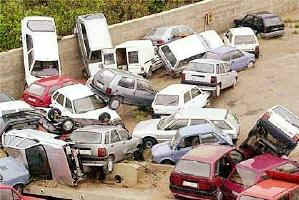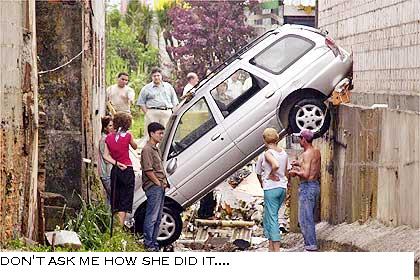Chapter 28: PARKING TIPS
PARKING ETIQUETTE - JAPANESE STYLE
Japanese drivers who park illegally not only get a ticket but also a brochure, advising them on how they are being rude, selfish and anti-social.
Japanese drivers also face a three strikes and your out rule for parking tickets. The punishment for scoring just three tickets in three years is a spell either working on school crossing patrols, handing out safety leaflets or wearing a sandwich board that appeals to fellow motorists to park properly.
CHOOSING A PARKING SPOT
Your first considerations when parking your car should be whether it is safe and legal. Check for the many designated parking zones, such as loading zones, no standing zones, no parking zones and clearway zones, some of which might have time limits or only apply during specific time periods.
Be cautious of the many prohibited parking places such as across driveways, bicycle paths, too close to an intersection, just over the crest of a hill, near a railway crossing or Post box, too close to a bus stop, too close to another vehicle, where you block the safe flow of traffic or parking in the emergency lane of the freeway (unless it is an emergency). Minimum parking distances apply for many of these and other circumstances. Get them wrong and your car may be towed away or cost you an expensive fine.
Once parked safely and legally, if you a car conscience person and care for your property, leaving your car unattended, at the mercy of others can create much anxiety.
It is not just the risk of theft but also the potential for damage to be caused by other drivers, pedestrians, cyclists or animals.
Your concern when parking and leaving your car is justified, we share the road with many drivers who are at best poor at parking or even reversing.
Even in a safe car with crumple zones and impact absorbing bumpers like this Proton damage can be caused by impacts from old cars with chrome bumpers, a 4WD bull bar or a tow ball from other car. This can cause costly and unsightly damage to your pride and joy.
It is true that sometimes you simply parked in the wrong place at the wrong time. The trick is not to park in the wrong place. Here are some simple tips when parking;
In a shopping centre car park never park near a shopping trolley storage area and likewise if parking near a discarded trolley, make sure you move the trolley to the storage area. Otherwise someone may push the trolley into your car.Some other suggestions include; Parking away from sporting ovals, don’t park behind the 18th green at your golf course. Nor under large trees during storms or high wind.
- Try and avoid parking beside a vehicle with a child seat on that side, a young child returning to the car can quickly open a door without thinking, hitting your car parked beside.
- Avoid parking beside a large vehicle like a van or 4WD that may obstruct your view when you go to leave the parking spot.
- If the car park is empty, park away from other cars, this will also make your car less attractive to car thieves. Parking at the other end of the carpark provides valuable exercise.
- If parking at night or it will be dark when you return park in a well lit area, for both personal security and theft prevention.
- The choice parking spot is where only one car can park beside such as at the end of the row beside the garden bed or kerb.
- Park in the middle of the allotted space, not too far in either. Other cars might arrive and park beside your car. Never try and park taking up 2 spaces, someone will always try and fill the gap.
- Your insurance company would prefer that you never park on the street overnight, but if doing so make sure you park facing the correct direction. The tail-lights reflect approaching headlights making your car more visible. If your car is damaged facing the wrong way your insurance may not be valid.
Also pick which tree you park under, otherwise you may return to find a smelly present left by a bird, bat, possum or other animal.
PARKING ON A HILL
When parking on a hill, the parkbrake (or handbrake as it is also known) is put to the test. A poorly adjusted, regularly misused or worn parkbrake may not hold the weight of the car.
Although unlikely in a new car, if the parkbrake won’t hold the car find a level parking spot and get your parkbrake serviced as soon as possible.
For added security though on a steep hill park the car in gear.
The correct procedure though is very important. Many drivers simply throw the car into gear (or Park in an automatic) and rip the handbrake on. In this example the weight of the car is usually held more by the selector pin in the automatic transmission (or gearbox) than by the parkbrake.
Whenever you are parking a car, park and stop safely. At this point your footbrake should be holding the car stationary, select neutral no matter whether the car has an automatic or manual transmission, pull on and apply the parkbrake. The correct way to apply the parkbrake is to push the button in as you are pulling it on. Avoid the ratchet sound and reduce wear on the metal teeth. Let the button out as the parkbrake is on, pull again firmly to hear one click, let your foot slowly off the footbrake, now the car’s weight is held by the parking brake, now select 1st gear in a manual or PARK in an automatic for added security.
On a steep hill also turn the steering wheel, so that the cars wheels are facing in the right direction.
For added safety when parking your vehicle on a steep uphill slope, turn your wheel out from the kerb so that if in the unlikely event of a handbrake failure, the rolling car may be restrained by the kerb.
If parking on a downhill slope, turn the wheels in to the kerb, so again the kerb my stop a runaway car.
RETURNING TO A PARK CAR: A CIRCLE CHECK
When returning to your parked car, always approach from the passengers side and undertake a CIRCLE CHECK. Walk around your vehicle, facing oncoming traffic to check for damage, eyeball your tyres and check for obstructions and your proximity to hazards. Check above your vehicle as well.
This simple procedure of looking for obstacles and hazards before driving off, even when driving from home would eliminate many avoidable collisions and those unfortunate incidents that occur every year of parents driving over their young children or pets as they reverse out of their driveway.
REVERSING
Considering that less than 1% of your driving time is spent reversing, it may surprise you that the most common cause of damage to many vehicles especially in company fleets is from reversing.
Luckily a reversing crash is usually at low speed and relatively low cost, but such a crash can be avoided by taking more care. Things to consider when reversing include;
- Ask yourself is it safe and necessary to reverse. Avoid reversing over a long distance, it may be safer and easier to turn around or go around the block and try again.
- When reversing you have no right of way. If a vehicle approaches from behind remain stationary and GIVE WAY until they pass.
- Only reverse slowly, turn your head, use your mirrors and check both sides. Look back and continue to look back whilst moving in reverse.
- If you find it hard to see behind, remove your seatbelt. Seatbelts are not required to be worn when reversing.
- Don’t be to shy or proud to ask someone to guide you. Remember it is less embarrassing to make another attempt than to crash.
- And don’t drive in and park so that you will have to reverse out with obscured vision. Reversing into a parking spot will allow you to drive out.
If vision is obscured reverse very slowly and cautiously, sound horn to warn other motorists, stop and check if uncertain and ask for help.
If you get the opportunity, especially if you start driving an unfamiliar vehicle (or new car) practice reversing to become aware of the vehicles turning circle, blind spots and handling characteristics. A Defensive Driving Course can give you a safe place to practice this forgotten art. If you have never reversed a trailer, be aware it can be a challenge especially if the trailer is small and it changes direction quickly or large and obscured your view.
With a trailer the same principles of reversing slowly and carefully, using mirrors, giving way to approaching traffic, asking for help, if unsure stopping to check the proximity of obstacles and being prepared to make several attempts will make sure you get your trailer safely where you want it in the end.
REVERSE PARALLEL PARKING
A reverse parallel park is one manoeuvre drivers learn when obtaining their drivers licence and then never use again, opting instead to find another parking spot than attempt a reverse parallel park.
It is not hard and with some practice and a good manoeuvrable car, it will become easy.
To commence, stop about 1 metre from the parked vehicle towards its front. Select reverse gear, cancel indicators. As reversing lights signal your intention.
Reverse slowly, until the rear window is in line with the rear of the parked car. Whilst moving slowly turn hard until the vehicle reaches 45 degrees then start to straighten the steering as required. Remember to give way to all traffic approaching from behind.
Be aware as you turn the car, that the front corner will trace a wider path into the flow of traffic.
Do not park closer than 1 metre from the other vehicles, you don’t want to be boxed in. Park using the parkbrake and gears correctly.
When returning to your vehicle remember to approach the passengers side and undertake a CIRCLE CHECK and before driving away remember to indicate and shoulder check blindspots.
(Written by Joel Neilsen, Managing Director, Safe Drive Training)





